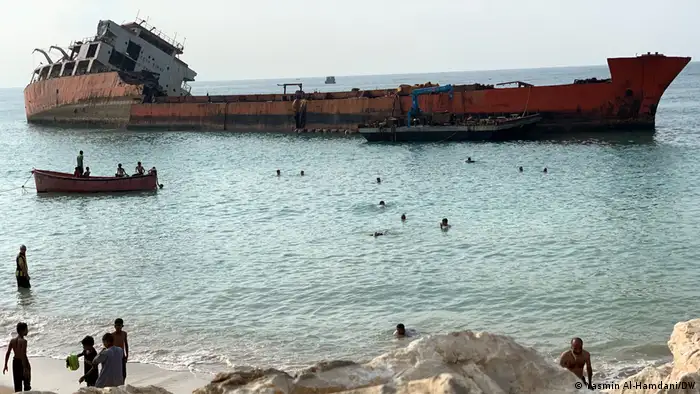DW AKADEMIE
Environmental journalism: Challenges and prospects in the Middle East and North Africa
DW Akademie asked journalists from the region about the most important aspects of covering climate change in the Middle East and North Africa.
The Middle East and North Africa (MENA) is among the world’s most vulnerable regions when it comes to climate change. It is one of the most water-scarce and dry regions on the planet, with high dependency on climate-sensitive agriculture and a large share of its population and economic activity in flood-prone urban coastal zones. The situation is about to get worse, especially when considered against a background of other pressures.
Given these stark projections, what environmental actions are being taken in the MENA region to insulate vulnerable segments of the population from climate shocks and how are they being communicated? At a recent DW Akademie session, over 40 journalists from across the region took part in a discussion on how the region can better communicate issues related to climate change. The main findings and call for actions have been summarized by media expert Karma Abu Sharif.
Regional needs and deficiencies
Inclusive development plans lacking: There is a clear and immediate need for greater focus on measures to reduce vulnerabilities, support disadvantaged and low resilience communities and adapt ways of living. Governments need to ensure that locally developed adaptation strategies are inclusive and that funding is adequately and justly distributed to those least resilient and frontline communities. Adaptation strategies must reflect their needs, cultural heritage and local traditional knowledge.
Capacities of journalists: Media coverage in the MENA region is limited to extreme weather events, government press conferences or international conferences on climate change. The most obvious is the lack of knowledge and expertise amongst journalists and within media organizations to cover climate change. More seriously, lack of knowledge has resulted in the dissemination of misleading information. While some training has been delivered by international NGOs, this has been sporadic, insufficient and with no follow-up. There is thus a pressing need for intensive and continuous training across media and civil society organizations.
Perceptions: There is a widespread assumption that people are not interested in climate stories, and that more pressing issues take precedence. Contrary to this assumption, recent research conducted by DW Akademie found that people in the region are aware of the climate-related changes that are taking place, as they are directly affecting people’s lives. Audiences are in urgent need for localized information on adaptation and mitigation strategies.
Lack of communication and coordination: While there are some worthy environmental initiatives in the region, especially from civil societies, there is an issue with lack of communication and coordination between key actors and the general population. The media has not been utilized as an effective medium of communication. For example, deficiencies in the media have undermined efforts to communicate the governments’ national environmental and adaptation strategies, and to solicit public responses to them. Without public buy-in and support, environmental strategies cannot be effective.
Target group-specific communication: There is a need for simple storytelling language in order to reach the average person. While the science is important, it is essential that stories are simplified and told in a way and in a language that people can relate to and understand. Furthermore, as this is an ongoing story. Some would argue that using constructive journalism - which provides solutions and presents success stories - is a good approach to keep the audience engaged, get information across and positively influence action.
Arabic as a journalistic challenge: According to several regional environmental journalists, the Arabic language is a challenge. Environmental stories are usually a translation from other western languages, yet with an absence of Arabic environmental terminology. Also, translating snippets of scientific stories without a full understanding of the topic or without contextualizing is not ony ineffective, but can be misleading.
Fake-news: Environmental fake news is a growing phenomenon. Scientists have warned that fake news about climate change and biodiversity loss is having a negative impact in the battle to halt the growing environmental threats to the planet. It is therefore important to have specialized scientists and fact-checkers who can act to curtail the spread of harmful content.
Calls for action:
1. Regional quantitative audience research on perceptions and information needs around environmental issues and climate change in the region. Such a study would provide valuable understanding of media behaviors of MENA populations as well as their opinions and feelings about environmental/ governance issues, priorities and areas of interest.
2. A database of trusted sources to improve environmental journalism and coordination amongst key actors.
3. Systematic and ongoing training from basic journalistic skills to programming/production. Training should take into account storytelling, constructive journalism, investigative journalism and messaging, in addition to other innovative journalistic skills.
4. Introduction of voices of local communities into media channels to express their needs, question officials over measures being taken and to have their say in decision-making processes. This may also help bring environmental issues higher up the news agendas of media organizations.
DW Akademie's “Digital Innovations for Peace” project is co-funded by the European Union and the Federal Foreign Office.
DW recommends
- Date 12.04.2024
- Feedback: Send us your feedback.
- Print Print this page
- Permalink https://p.dw.com/p/4efOe
- Date 12.04.2024
- Send us your feedback.
- Print Print this page
- Permalink https://p.dw.com/p/4efOe

